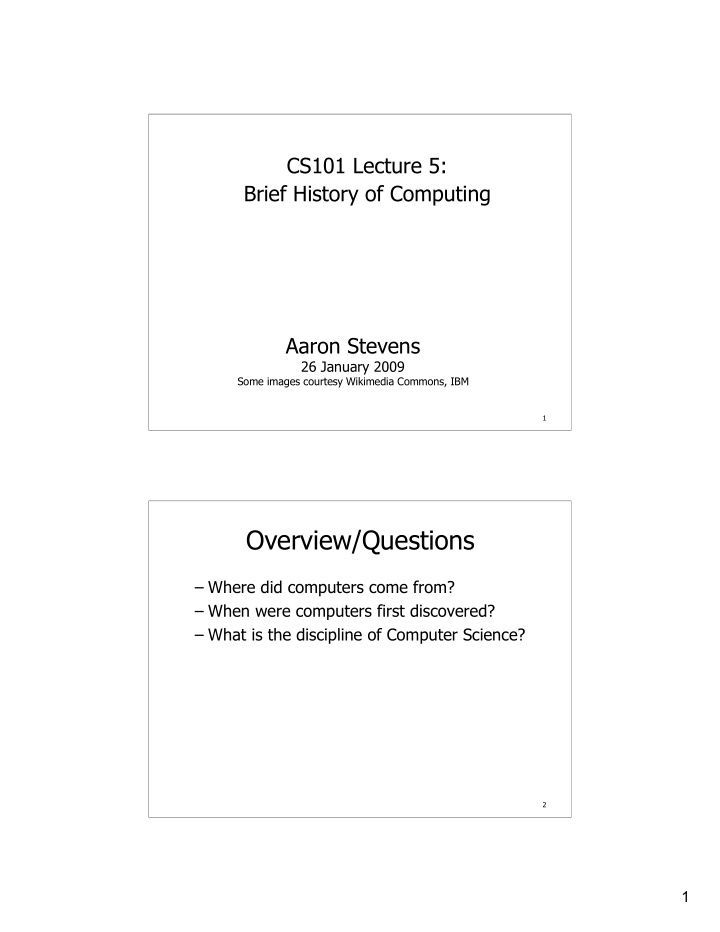



CS101 Lecture 5: Brief History of Computing Aaron Stevens 26 January 2009 Some images courtesy Wikimedia Commons, IBM 1 Overview/Questions – Where did computers come from? – When were computers first discovered? – What is the discipline of Computer Science? 2 1
Why should we care? “Predictions are that by 2013 a supercomputer will be built that exceeds the computation capability of the human brain.” http://www.youtube.com/watch?v=ljbI-363A2Q Is this for real? 3 Why should we care? “Predictions are that by 2049 a $1000 computer will exceed the computational capabilities of the human race.” http://www.youtube.com/watch?v=ljbI-363A2Q Is this for real? 4 2
Early History of Computing Abacus (2400 BC) Ancient device to record numeric values Above: a reconstructed Roman abacus 5 Early History of Computing Blaise Pascal (1623-1662) Mechanical device to add, subtract, divide & multiply 6 3
Early History of Computing Joseph Jacquard (1801) Jacquard’s Loom, the punched card 7 Difference Engine Charles Babages’ mechanical calculating machine, designed in 1820s. 8 http://www.youtube.com/watch?v=KBuJqUfO 4 4
Early Digital Computers Harvard Mark I (1944) 9 Harvard Mark I 10 5
Early Digital Computers Harvard Mark I (1944) First fully automatic digital computer to be completed • 51 feet wide, 8 feet high, 2 feet deep • Built out of switches, relays, and rotating mechanical shafts/clutches • Storage for 72 numbers, each 23 decimal digits in length • Read instructions from paper tape, one at a time 11 First Computer Bug Log of first computer bug, discovered by Grace Hopper, 1945 12 6
Video: Triumph of the Nerds PBS Series hosted by Bob Cringely http://video.google.com/videoplay?docid=-2539790754467363791 9:24 - Cringely explains digital computing, program, 10:00 - data, instructions in binary, flipping switches, etc. Grace Hopper, programming COBOL, mainframe computers, punch cards, Wozniak, Jobs on programming, 12:58 - microprocessor (vacuum tubes, transistors, chips ), Intel 15:30 - Altair 8800 19:20 - Homebrew computer club 20:30 - Mellon/Garland @ computer club, binary addition by flipping switches 22:30 - programming language/basic interpreter, Paul Allen, Bill Gates // 27:00 13 Video: Triumph of the Nerds PBS Series hosted by Bob Cringely http://video.google.com/videoplay?docid=-2539790754467363791 27:00 - Microsoft in Albuquerque, basic for the Altair 29:12 - Steve Jobs, Jim Warren, sixties counter culture 31:30 - Apple Computer, Apple I, II // 35:00 35:00 - venture capital for apple, apple II, manufacture 37:10 - computer fair 40:00 - Intro VisiCalc on an Apple II 44:38 - wall street use of PC 46:15 - wrap up characters 48:50 - closing remarks 14 7
Moore’s Law 15 Take-Away Points – Mechanical Computers – Programmability (revisited) – Digital Computers – Moore’s Law 16 8
Student To Dos – Readings this week: Reed ch 4, pp 64-79 (today) Reed ch 3, pp 44-50 (Wednesday) – HW02 due Tuesday 1/27 – Quiz 1 is on Friday 1/30 17 Early Personal Computers Computer Ads: http://blogs.pcworld. com/techlog/archives/002950.html Atari 400 (1980) http://www.youtube.com/watch?v=5sr28fygmOQ Commodore VIC-20 (1981) http://www.youtube.com/watch?v=gVX5cyMOGAk Compaq portable computer http://www.youtube.com/watch?v=YTMdXZ_QwTo 18 9
Additional Pictures: Covered in videos (more or less) 19 First Generation Hardware (1951-1959) Vacuum Tube Stored a single element of memory (on or off) 8 20 10
First Generation Hardware (1951-1959) Magnetic Drum Memory device that rotated under a read/write head 8 21 First Generation Hardware (1951-1959) Punch Card 8 22 11
First Generation Hardware (1951-1959) Magnetic Tape Drives Auxiliary storage devices. 8 23 Second Generation Hardware (1959-1965) Transistor Replaced vacuum tube, fast, small, durable, cheap 9 24 12
Second Generation Hardware (1959-1965) Circuit Boards Transistors were soldered together 9 25 Second Generation Hardware (1959-1965) Magnetic Disks 9 26 13
Third Generation Hardware (1965-1971) Integrated Circuits Replaced circuit boards; transistor on a silicon wafer chip – smaller, cheaper, faster, more reliable 27 10 Third Generation Hardware (1965-1971) Terminal An input/output device with a keyboard and screen The Digital Equipment Corporation VT05, introduced 1970 28 10 14
Fourth Generation Hardware (1971-?) Large-scale Integration Thousands of transistors on a single chip Die of an Intel 80486DX2 microprocessor (actual size: 12 × 6.75 mm) in its packaging. Released in 1992, it has 1.2 million (1.2 X 10 6 ) transistors. 29 11 Fifth Generation Hardware (1990-?) PCs, the Commercial Market, Workstations Personal Computers and Workstations emerge New companies emerge: Apple, Sun, Dell … Laptops, Cellphones, PalmPilot, iPod, etc. Everyone has his/her own portable computer - or several of them. Internetworking Virtually all computing devices connected to the Internet. High-speed and wireless connections are common. 30 11 15
Recommend
More recommend